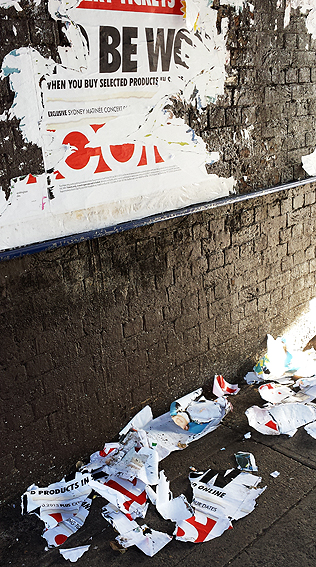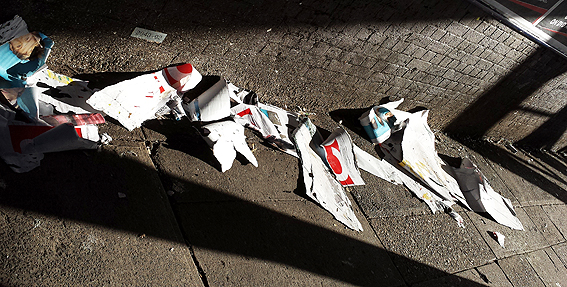Anybody feeling the urge to fulminate about the environmental vandalism of paper should look no further than the street poster. Arriving in the dead of night, these fugitive print propagandists seek to colonise any free public space, from poles to construction hoardings, spreading like a fungal growth.
It’s bad enough that, in situ, they blight our nice, clean, empty spaces with their gaudy colours and bold images, what’s worse is that, once, up, they must come down, typically in the aftermath of a rain storm when they are sloughed off like dead leaves. Then away they go, shredded and scattered, driven hither and thither by the wind, littering the footpaths, congregating in our drains and waterways.
That’s the problem with paper; it’s just so damn obvious (you don’t see discarded television signals lying around, do you? Or bytes). If only it could be more discrete, delicately flushed away with all the other waste products rather than doing its business in the street.
But that’s also the reason why advertisers like it, because it is so hard to ignore, even if the sideways looks and cursory glances provoke pin-pricks of irritation and anxiety in passers-by. Made you look. As Todd Sampson, ABC TV Gruen Transfer panellist, commented, the appeal of billboards and posters as a marketing tool is that they are “one of the few forms of advertising that’s beyond the reach of the empowering remote control or the dismissive mouse.”
So maybe part of the reason why bill posters regularly raise the ire of the authorities is because they can’t be controlled. They are an imposition. They impinge upon our consciousness whether we like it or not (and usually we don’t), whether we need them or not (and sometimes we do, if only to discover something we didn’t know).
Posters are among the most ephemeral print products in the public space, not just because they appear and disappear like tradesmen, there one minute and gone the next, but also because of what they chronicle, the never-ending cavalcade of minstrels and troubadours which passes across the stage. If somebody was to chart the disposable world of street posters over the years (and no doubt somebody has), the result would be a flicker-book of changing musical tastes and fashions, a chronology of the rise and fall (and revival) of generations of singers, comedians and entertainers.
This is history that’s lying on the pavement, scraps of the quotidian, never to be repeated.



